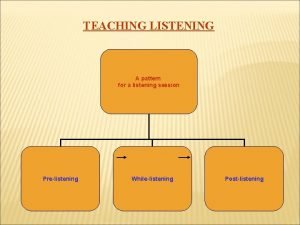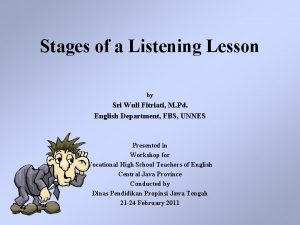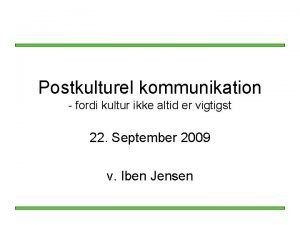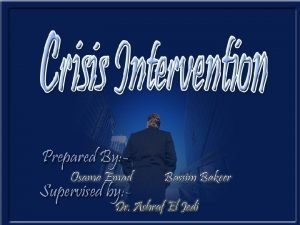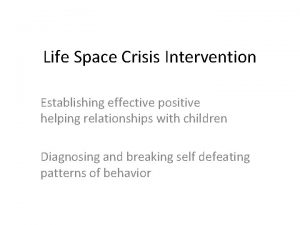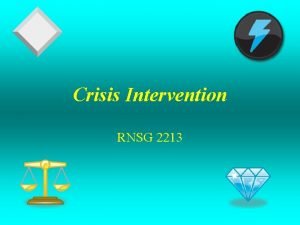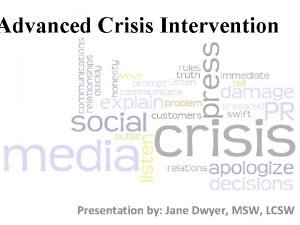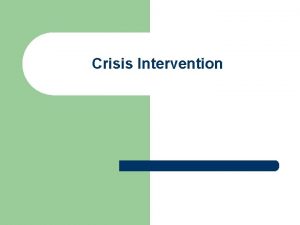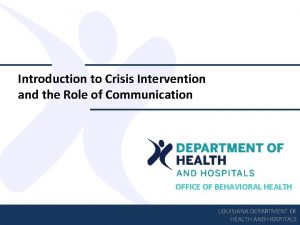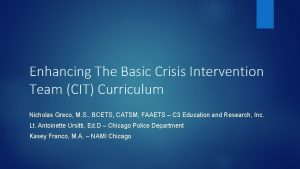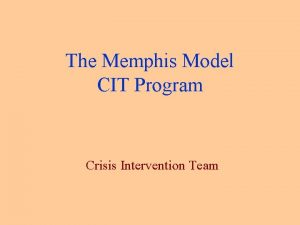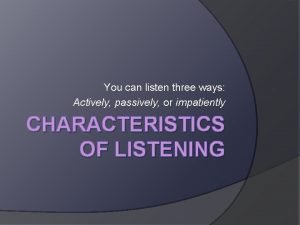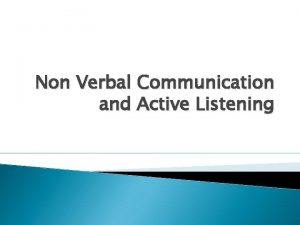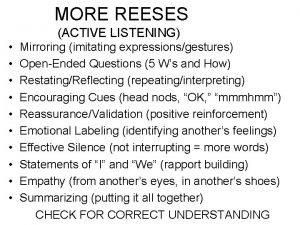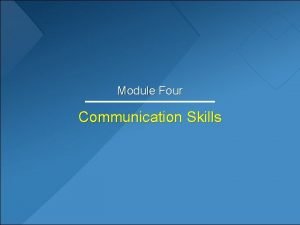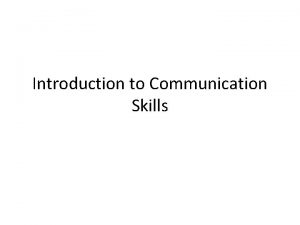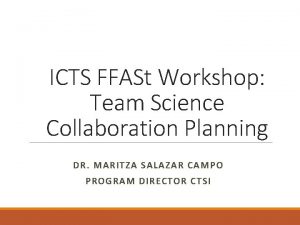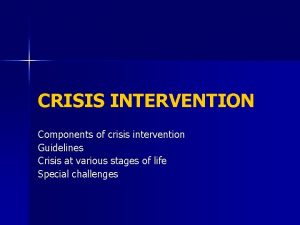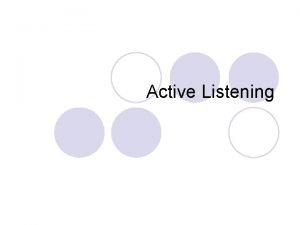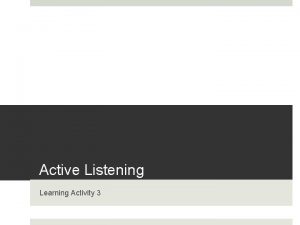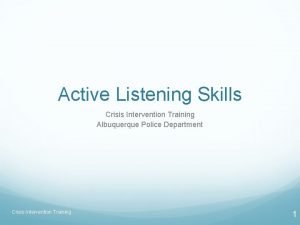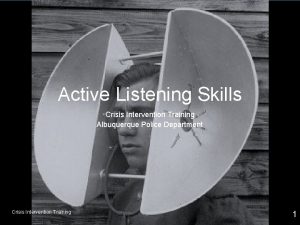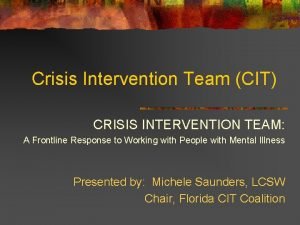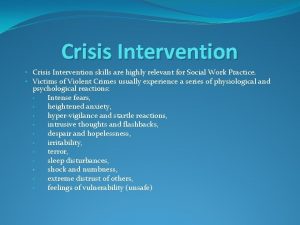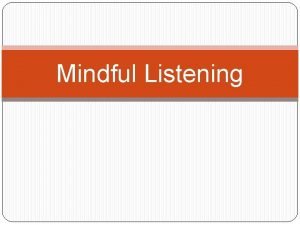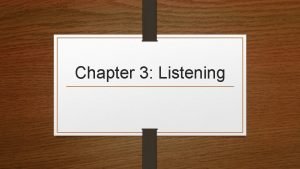Active Listening for Crisis Intervention Det David John


































- Slides: 34

Active Listening for Crisis Intervention. Det. David John Jaramillo Albuquerque Police Department Crisis Negotiation Team

Training and Credentials • • APD’S INTRO/BASIC NEGOTIATIONS FBI PATC’S CERTIFICATION COURSE. CURRENT MEMBER OF APD’S CNT TEAM.

PURPOSE • Give uniformed police officers the tools to deescalate subjects that are in crisis

OBJECTIVES • • • Define crisis What causes people to go into crisis Types of listening Initial contact Arrest and transport authority Tactics and safety when dealing with people in crisis

What is a Crisis? • Subjects ability to cope has been exceeded • Usually precipitated by a life altering/changing occurrence within the last 24 -48 hours • • Divorce Job loss Illness Psychotic Break

Maslow’s Hierarchy of Needs • • • Self Actualization Self-Esteem Love and Belongingness Safety and Security Physiological Needs

Crisis Continued • Crisis Intervention • Short term , time-limited intervention, designed to re-establish a person’s equilibrium and solve an immediate problem.

Crisis EMOTION REASON

Crisis Intervention • Rapport-----Negotiation------Resolution REASON EMOTION

Attributes of a good Communicator • Good Talker Vs. Good Listener • Car Salesman/ Telemarketer • Negotiator

Attributes Cont. • • Patience Confidence Maturity Ability to think outside of the box

Two Levels of Communication • Content – Just the Facts • Emotion – Feeling about the facts

Active Listening • Not only Listening to the subjects words but identifying the emotions and meaning behind them • Active listening is the key element in any successful negotiation/intervention

Seven Active Listening Skills • • Emotion Labeling Open Ended Questions Paraphrasing Effective Pauses Reflecting/Mirroring I statements Minimal Encouragers

Emotion Labeling • Labels the emotion behind what is being said • Example • “There is a dark cloud over me, nothing is fun, and I can’t get a decent nights sleep. ” • It sounds like you are really depressed.

Paraphrasing • Clarifying or rephrasing the speakers words into your own words. • Example • “She is always talking and she doesn’t care what I say” • Sounds like she doesn’t listen to you

Paraphrasing Continued • Example • “I am getting a divorce and I am really afraid that I will never see my kids again. ” • Losing your kids seems to be a huge concern for you.

Effective Pauses • Silence between important thoughts – Silence is very uncomfortable for most people – Gives the speaker the chance to gather their thoughts. – Usually appropriate when something important is said.

Reflecting/Mirroring • Repeating the last few words that were said • Example • “When she talks about taking my retirement I feel really trapped. ” • “Like your trapped” • Voice inflection is very important • Should not be used often

Minimal Encouragers • Lets the speaker know that you are still there • Allows the conversation to continue without interruption • Example – Uh Huh – OK – Really

I Statements • Allows you to tell the speaker how you feel and conveys concern in a non-threatening manner which does not put the subject on the immediate defensive. • Example: – When you say things like that I feel really upset because we were really making some progress

Active Listening Continued • • • Seven Principles Good to start dialogue and gain rapport Good to use when dialogue stalls If you use it too much will sound robotic Aim to have a normal conversation with the subject, allowing them to vent and directing them toward you ultimate goal!

Barriers to Active Listening • • • Arguing Ordering Judging Pacifying Derailing Moralizing

Making Initial Contact • Reduce the amount of external stimulus (sirens, non-essential personal, radio volume) • Introduce yourself using your first name and ask for theirs. • The quicker you can gain some kind of compliance and find common ground. The quicker you will resolve the incident.

Initial Contact Continued • Remember there is not a right or wrong thing to say • People respond differently • You will be judged on how you can recover • A sincere apology is usually the best way to regain rapport. • Encourage positive behavior by saying thank you (remember to take baby steps)

Initial Contact Continued • Remember your non-verbal • Large amounts of communication is done without any words • Posture • Yawning • Laughing • Appearance (Uniform)

What to expect when responding to emotionally disturbed persons. • You will be dispatched to resolve suicide and mental health pick up orders. • Responsible for difficult decisions • Pre-swat – PA’s – First contact

43 -1 -10 Emergency Mental Health Transport • A peace officer may detain and transport a person for emergency mental health evaluation and care in the absence of a legally valid order from the court only if; – 1. Person otherwise subject to arrest – 2. Officer has reasonable grounds to believe that the subject has just attempted suicide – 3. Based on an officers observation and investigation has reasonable grounds to believe that the subject as a result of a mental disorder presents a likelihood of serious harm to himself or others and immediate detention is needed. (grave passive neglect) – 4. C of E

Arrest or Not that is the Question • CIT started as a jail diversion program • Taken too far at times (having mental illness is not a get out of jail free card). – Domestic Violence – Resisting or Obstructing, displaying a propensity to violence – Weapon involved • It is not an either/or question. Jail should mental health services

Documentation • Synopsis should include what part of (43 -1 -10) used. – Example: Based on my investigation and observations I had reason to believe “Joe” posed an imminent threat to himself and or others. • Narrative should describe what you observed – Example: “Joe” told me that he has plans to climb up on the bridge and disable all of the traffic cameras.

Safety and Tactical Considerations

Safety and Tactical Considerations • Hearing Voices • What are the voices telling you • Distance – Giving up ground doesn’t = defeat • Suicide = Suicide by Cop • Pat Downs – Render the subject safe – Reduces exigency increases ability to talk

Tactics and Safety Continued • • Less Lethal Option Cover vs. Concealment Talking behind a Gun Run your belt tape

Conclusion • • Defined Crisis Active Listening Increased confidence on initial contact Tactics and Safety • Det. D. Jaramillo 875 -3518
 Pre listening activities
Pre listening activities Pre listening while listening post listening activities
Pre listening while listening post listening activities Active and passive listening
Active and passive listening Vilken grundregel finns det för tronföljden i sverige?
Vilken grundregel finns det för tronföljden i sverige? Kolposkopi, px
Kolposkopi, px Det beskrivende og det komplekse kulturbegreb
Det beskrivende og det komplekse kulturbegreb Det finns bara en gud och det är allah
Det finns bara en gud och det är allah Balancing factors crisis intervention
Balancing factors crisis intervention Nova crisis intervention model
Nova crisis intervention model Hybrid model of crisis intervention
Hybrid model of crisis intervention Life space crisis intervention
Life space crisis intervention Balancing factors crisis intervention
Balancing factors crisis intervention Hybrid model of crisis intervention
Hybrid model of crisis intervention Characteristics of crisis intervention
Characteristics of crisis intervention Non violent crisis intervention techniques
Non violent crisis intervention techniques Caplan model of crisis intervention
Caplan model of crisis intervention Cpi rational detachment
Cpi rational detachment School crisis prevention and intervention
School crisis prevention and intervention Safer model crisis intervention
Safer model crisis intervention Crisis intervention
Crisis intervention Basic crisis intervention
Basic crisis intervention Cit memphis model
Cit memphis model Bucks county crisis intervention team
Bucks county crisis intervention team Myasthenic crisis vs cholinergic crisis
Myasthenic crisis vs cholinergic crisis Critical listening
Critical listening Deliberative listeners strive to remember information and
Deliberative listeners strive to remember information and Insulated listening
Insulated listening Listening vs hearing
Listening vs hearing Non verbal active listening
Non verbal active listening Mirroring active listening
Mirroring active listening Sier hierarchy of active listening
Sier hierarchy of active listening Active listening is focused and purposeful
Active listening is focused and purposeful Active listening definition
Active listening definition Morepies active listening
Morepies active listening Active listening drawing activity
Active listening drawing activity
